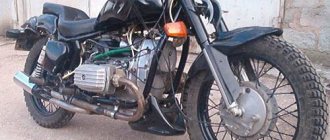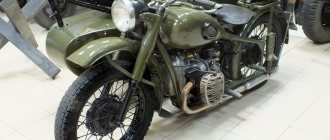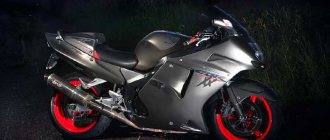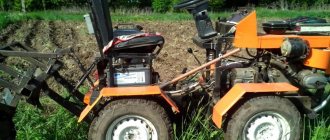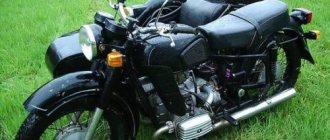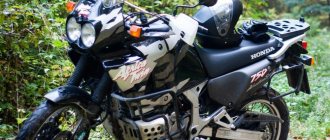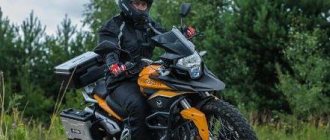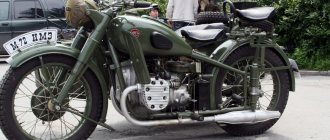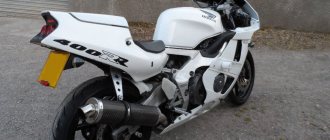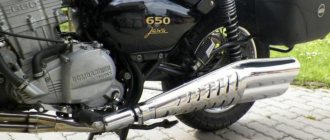RU-MOTO rating
- Reliability
- Chassis
- Appearance
- Comfort
4.5
Verdict
Looking at such motorcycles, you understand the approach with which the equipment was created. The dominant factor was the creation of a durable, workhorse, and such concepts as comfort, appearance and dynamics faded into the background. Now such an idea will not find its consumer. Therefore, the Dnieper has already become an interesting page in our history.
The Dnepr motorcycle is a child of the Kyiv motorcycle plant. Given its characteristics, there is no need to talk about a bright plastic fairing, acceleration to a hundred or noisy shots along the avenue. This is not about him, but he doesn’t need it, his path is different - he is a real hard worker.
Motorcycles of this brand appeared immediately after the war, and went through a thorny path in such difficult years for the industry. Now we are accustomed to perceiving a motorcycle as a luxury item, but back then, with a shortage of automobiles, it was an irreplaceable thing. The Dnepr could be used not just as a motorcycle with a sidecar for the family, but as a tractor and a truck, carrying the difficult life of a Soviet person on its shoulders.
Dnepr M-72 prototype - German BMW R-71
It is also interesting that the first-born in the line - the M-72 motorcycle - became the Soviet incarnation of the German representative BMW R-71.
The lineup then looked like this:
- 1952 - model M72;
Dnepr M-72
- 1958 - model K750;
Motorcycle Dnepr K-750
- 1963 - model K750M;
Motorcycle Dnepr K-750M
Read other motorcycle reviews of HONDA CBR1100XX – a fast motorcycle for brave people
- 1968 - model K650 “Dnepr” (MT-8);
Motorcycle Dnepr K-650
- 1971 - model MT-9;
Motorcycle Dnepr MT-9
- 1974 - model MT-10;
Motorcycle Dnepr MT-10
- 1976 - model MT-10-36;
- 1978 - model MT-12;
Motorcycle Dnepr MT-12
- 1985 - model MT-11;
Motorcycle Dnepr MT-11
- 1986 - model MT-16;
Motorcycle Dnepr MT-16
- 1991 - model Dnepr KMZ 8.157.01 “Solo”;
Motorcycle Dnepr KMZ 8.157.01 “Solo”
Read other motorcycle reviews Review of the Minsk D4 125 motorcycle
- 1991 - model Dnepr KMZ 8.157.02.
Motorcycle Dnepr KMZ 8.157.02
There were other models, but they were less common and highly specialized. And as an example for study, we decided to take the MT-10-36 model.
Specifications
All this difficult contraption had to be driven by a boxer, four-stroke engine with a volume of 650 cm3. This motorcycle was very different from the majority of the Soviet motorcycle industry, represented by two-stroke small-capacity models. The unit produced 36 hp per 335 kg of mass and could accelerate this “tank” to 105 km/h.
Previously, the site Ru-moto.com published a review of the Voskhod 3M motorcycle
The motorcycle was air-cooled, but the arrangement of the cylinders made it possible to catch the air flow well. With this design, it was possible to adapt and dry shoes while driving (there is evidence that German soldiers used this in their BMWs).
The special feature and main advantage is the large load capacity of 260 kg (as stated by the manufacturer). Of course, few people took this into account; the motorcycle was overloaded two or even three times. However, many of these specimens are still alive and continue to work in rural areas. You can draw your own conclusions about the former power of the structure.
Equipped with a four-speed gearbox and, as befits a heavy motorcycle, one reverse gear.
Motorcycle Dnepr MT-10-36
The motorcycle frame clearly showed itself to be a durable unit. You can make sure by looking at what loads this motorcycle can transport. This strength is due to the presence of the stroller, since when constantly driving with it, the frame experiences unidirectional loads and deforms. This can be seen on lighter motorcycles with sidecars, such as Java, Izh.
The suspension of the motorcycle consisted of a telescopic fork on a hydraulic shock absorber at the front, and a pendulum on shock absorbers at the rear. Dnepr can be called quite comfortable. The cross-country ability, despite the weight and dimensions, was also satisfactory - the motorcycle had to go everywhere.
Everything regarding electrical equipment remained rather archaic; the only serious step in this model was the transition to the 12th century. The engine was started using a kickstarter.
The consumption according to the passport was 8 liters, but in reality, under harsh operating conditions, it went well beyond 10 liters, but then few people worried about it. About 19 liters fit into the tank.
| Total information | |
| Max wheelbase (length between front and rear wheel axles) | 1500 mm |
| Min clearance between the ground and the bottom of the chassis (clearance) | 125 mm |
| Max length with stroller | 2430 mm |
| Max height with stroller | 1080 mm |
| Max width with stroller | 1680 mm |
| Max dry weight: | |
| with stroller | 335 kg |
| without stroller | 220 kg |
| Max load capacity (weight of driver and two passengers) | 260 kg |
| Max speed | 105 km/h |
| Max braking distance from speed | 60 km/h 30 m |
| Max fuel consumption per 100 km | 8 l |
| Max oil consumption per 100 km | 0.15 l |
| Max noise level | 86 dB |
| Engine | |
| engine's type | four-stroke, carburetor, overhead valve, two-cylinder |
| Cylinder displacement | 649 cm3 |
| Compression ratio | 7,5 |
| Cylinder diameter | 78 mm |
| Piston stroke | 68 mm |
| Max power | 26.5 (36) kW (hp) |
| Speed corresponding to maximum power | 5600–5900 rpm |
| Max torque | 47 (4.8) N•m (kgf•m) |
| Speed corresponding to maximum torque | 4900–5200 rpm |
| Carburetor type | K301D |
| Fuel | gasoline A-76 or A-72 |
| Air purifier | combined - inertial and contact-oil |
| Cooling | air |
| Power transmission | |
| Clutch | dry, double disc; driven discs with friction material linings on both sides. The clutch release drive is double: manual - from the lever on the steering wheel; foot - interlocked with the gearbox shift mechanism |
| Transmission | four-speed, with reverse gear |
| Gear shift | foot pedal to engage four main gears; manual reverse lever |
| Gear ratios in the gearbox: | |
| 1st gear | 3,6 |
| 2nd gear | 2,28 |
| III gear | 1,7 |
| IV gear | 1,3 |
| reverse | 3,67 |
| main gear | spiral-conical |
| Final drive ratio | 4,62 |
| Chassis | |
| Frame | tubular, welded |
| Rear wheel suspension | lever on double-acting spring-hydraulic shock absorbers |
| Front fork | telescopic, with double-acting hydraulic shock absorbers |
| Wheels | interchangeable, easily removable, with cast housings, adjustable tapered roller bearings |
| Brakes | chocks, adjustable on the front and rear wheels of a motorcycle |
| Tires | 95–484 (3.75–19) mm (inches) |
| Stroller | single-seater, passenger-type body, sprung with rubber springs; wheel on a lever suspension with a spring-hydraulic shock absorber |
| Stroller frame | tubular, welded |
| Electrical equipment | |
| Accumulator battery | 3MT6 – 2 pcs. (or 6MTC9 – 1 pc.) |
| Alternator | 12 V, 150 W G424 |
| Relay regulator | PP330 |
| Ignition system | battery, 12 V with automatic ignition timing control |
| Ignition coil | B204 |
| Breaker | PM302-01 |
| Candles | A10HT or A11H |
| Sound signal | C38 |
| Speedometer | SP102 |
| Speedometer flexible shaft | GV127 |
| Brake light switch | VK854 |
| Light switch | P25-A |
| Turn signal switch | P201 |
| Turn signal relay | PC427 |
| Emergency oil pressure sensor | MM126 |
| Signal lamp | PD20E, PD20D |
| headlight | FG137 |
| Back light | FP246 |
| Sidecar rear light | FP219B |
| Stroller front light | PF232B |
| Turn signal lamp | UP223B |
| Central switch | VK857 |
| Capacities | |
| Fuel tank | 19 l |
| Crankcase | 2.2 l |
| Gearbox housing | 1.5 l |
| Final drive housing | 0.11 l |
| Front fork leg | 0.13 l |
| Shock absorber | 0.105 l |
| Basic data for adjustment and control | |
| Gap between rocker arm and valve on a cold engine (at 15–20°C) | 0.07 mm |
| Gap between breaker contacts | 0.4–0.6 mm |
| Gap between spark plug electrodes | 0.6–0.75 mm |
| Wheel tire pressure: | |
| stroller and front | 0.15–0.16 (1.5–1.6) MPa (kgf/cm2) |
| rear | 0.26–0.27 (2.6–2.7) MPa (kgf/cm2) |
| Gap between spark gap and ignition coil terminal | 8-9 mm |
"Escort-86"
The country's leadership liked Dnepr-14.9, but wanted something better.
The customer had comments on stability, handling, weight, reliability, driver protection and ergonomics. Therefore, in 1979-80. The factory workers included a fundamentally new escort motorcycle, the Escort-86, in their plan for creating new equipment. The designers of the Kyiv Motor Plant began working on a promising new product, taking into account the operating experience of the Dnepr-14.9, comments on it and the wishes of the Kremlin. However, the experimental site of the OGK was constantly busy with “routine”: first with the improvement of the first batch of Dnepr-14.9 motorcycles and the production of spare parts for them, and then with the production of the second batch of these motorcycles. Therefore, the production of Escort-86 prototypes was delayed, and their testing was never completed. The high demands of the customer, VNIImotoprom (the leading motorcycle institute in the USSR) and the VNIIBD of the USSR Ministry of Internal Affairs for the design and technical characteristics of the designed motorcycle could only be satisfied by the creation of units and components that were significantly different from those used in mass production at KMZ. “Escort-86” was supposed to have an engine with a displacement of 950 cm3, a five-speed gearbox with reverse gear, cast wheels, a double-disc front wheel brake, a front fork with aluminum housings and a number of other solutions that had never been used before (in the USSR, of course) .
“Escort-86” was created in those Soviet times, famous for bureaucratic confusion, when even the same department made directly opposite decisions.
The industry Union Ministry, which first approved the technical specifications for the Escort-86, soon “drew the attention of the plant’s technical management to the inadmissibility of the practice of designing new motorcycles without taking into account international practice and complete de-unification with serial products” and recommended that KMZ “provide all the necessary materials for review of the design and parameters of the new escort motorcycle at the NTS of the Ministry of Automotive Industry.”
KMZ presented two Escort-86 motorcycles to the Ministry of Automotive Industry, but they only marveled and asked: “Who... came up with the idea to do this?” As a result, the Scientific and Technical Council of the Ministry of Automotive Industry (motorcycle manufacturing section) decided “due to the presence of serious shortcomings in the design of the sample Escort-86 motorcycle presented by the Kyiv Motorcycle Plant, work on its development should be stopped.” This decision was approved by Deputy Minister of Automotive Industry E. Bashindzhagyan and VPO Soyuzmotoveloprom, instead of Escort-86, included a simpler task in the KMZ plan for new equipment: “Creation of a motorcycle for escort based on the Dnepr-14.9 motorcycle.”
The same section of the motorcycle and bicycle industry of the NTS of the Ministry of Automotive Industry also predetermined the directions for modernizing the existing escort motorcycle: increasing its reliability and trouble-free operation, reducing weight, improving dynamic, ergonomic qualities and driver protection, as well as increasing the stability of the motorcycle at high speeds.
And since no one allocated funds for the creation of a new model, it was decided to modernize the existing motorcycle and produce it under the same name, adding the letter “M” to it.
Repair
Of course, there is no need to talk about any kind of service in the service. And when owning such a motorcycle, experience plays an important role, because all the pain of repairs falls on your shoulders.
Repair and maintenance Dnepr MT-10-36
Already from the moment of break-in you have to put your hands into it. During this period, the valves require adjustment every 350-500 km, then this procedure is repeated after 1-1.5 thousand km.
Despite all the proper maintenance, the cylinder-piston group has a low, by modern standards, resource, and this should be taken into account.
Also, the constant leakage of oil is not surprising; the quality of manufacture of the oil seal seats leaves much to be desired.
Burnout of the cylinder head gasket was also not uncommon. It is important during operation to keep the oil sensor in constant working order; any reason leading to oil starvation will quickly kill the engine, and the likelihood of such a reason occurring is high.
Tuning
In Soviet times, a small abundance of equipment provoked people to individualize their motorcycle, and the Dnepr has seen many different modifications over the years.
Conversion of the Dnepr MT-10-36 into a bobber
Read other motorcycle reviews of the BMW S1000 RR: detailed review
Initially, it is worth approaching the refinement of factory jambs:
- improvements to the lubrication system;
- replacing carburetors with Japanese ones;
- installation of automobile rings and pistons;
- modification of the cylinder head and installation of automotive valves.
But often, the Dnepr is not only subject to improvement of engine components, but also serves as the basis for the construction of a completely new, custom motorcycle. In most cases, Dneprs are converted into a chopper or bobber, since a heavy motorcycle is the most suitable option for this. But there are sports and cafe racers based on the Dnieper.
Owner reviews
AwN
I inherited the Dnieper from my grandfather, who was a good mechanic and engineer. From the cradle I spent all my free time in the garage near the motorcycle and learned a lot. Not only is it good to drive and ride an iron horse, but also to disassemble and tune the Dnepr. I believe that the creation of the Kyiv Motorcycle Plant is one of the best Soviet motorcycles. The Dnieper was built for use (mainly) in rural areas. Since it has enormous torque and engine power, it is indispensable for any farmer, both for transporting cargo and for simple trips. Due to its characteristics, this motorcycle was widely used by land reclamation workers and agronomists in the south of Ukraine. Dnepr is known for its reliability and longevity. In 25 years, only a few small parts have been replaced on my motorcycle. The maximum load capacity is 460 kg (this includes passengers and the driver), although this is not the limit. For example, I loaded 550 kg and nothing happened, only the Dnepr’s handling sharply decreased. The motorcycle's appetite for gasoline is moderate; it consumes 6-7 liters per hundred kilometers, depending on the ride. Another advantage of the MT is the presence of a reverse gear, which sets it apart from other brands of motorcycles, and also improves its cross-country ability and maneuverability on wet and narrow roads. A soft wheel suspension with shock absorbers, a reliable braking system, a comfortable saddle and ease of control create conditions for a comfortable ride on any road.AwN
sasis
If you took this motto, you won't regret it. A real car, it goes away from under itself... eh... swallow, this is a good motorcycle! Often moto lovers say that it turns the liners quickly... I would tell them how it turns them... you need to ride less without oil... I know this from my own experience... you can’t give it much to a standard MT-10... but if the bridge is high-speed... yes the box is stitched... that 160 goes without b... the main thing is to fake it for yourself if of course you're good at it... and if not, then I don't recommend it... It's better to go to a car service... that's where they make it. I do this myself and it costs 10 in the garage too... and yet it’s a good moto...! even if you take it, don’t think it will be useful to you in any situation.sasis
retro0000
Hello! I would like to share with you my personal experience in operating the Dnepr MT-10 motorcycle. The manufacturer of this vehicle is the Kyiv Motorcycle Plant. My father bought the motorcycle in 1988, then it gradually came into my use. Why is this motorcycle called “heavy”, because its weight is 350 kg, it is ideal for rural areas, the cross-country ability of this motorcycle is excellent, and even more so if it also has a wheel drive (motorcycle body), after all, the engine is 32 horses . In terms of fuel consumption, I will say that per 100 km/8-9 liters of gasoline is more than the consumption of Lada cars with well-adjusted valves. And I don’t believe those who say that the consumption is 5-6 liters - this cannot be. One bad thing is that the metal of the MT-10 motorcycle sidecar is not very durable, compared to the Ural K-700, namely, it rotted very quickly along the welding seams. But overall, I’m very happy with the motorcycle, it still rides to this day, although I’ve had to change a lot over the past 26 years. Advice - if you still have MT-10 motorcycles, don’t sell them at any price, this is an “old school” technique. retro0000
I would like to talk a little about unusual and little-known KMZ models, some of which I own. Today the story will be about 8.955-01 and 8.955 Please note that in my materials I cannot use documented facts, but only data taken from personal communication with factory workers: assemblers, mechanics, testers, inspectors, etc. Therefore, my material is not of a reference nature, but, most likely, reflections on the topic. So, let's get started. After the collapse of the USSR, the direction of escort motorcycles at KMZ simply died out for obvious reasons. Long before the collapse, the plant was dealing with the issue of motorcycles without sidecars for the civilian market, although not the Union one. Immediately after the collapse, trying to somehow survive, the plant tried to sell its wheelchairs and SOLO wherever possible. Among other things, the plant was interested in state orders, and there is information that KMZ tried to supply its newly minted 8,157 SOLO to the newly degenerate state for service in the traffic police. There were no centralized orders for obvious reasons, and the motorcycle itself, against the backdrop of arriving foreign cars, was no longer so interesting and relevant. But some regional departments of Ukraine bought 8,157 SOLO and used them as official patrol motorcycles. A distinctive feature is the light gray color, special signals (different everywhere) and Izhevsk fairings. I’ve seen several of these, I have an idea to build myself such a DAI-mot. This was not a solution or even a half-measure. The plant needed an order from the traffic police. Escort models were too expensive and exclusive, in terms of spare parts and complexity of production. After all, this area under the USSR was subsidized, not profitable.
The result of these efforts in the mid-90s was the 8.955 motorcycle, which was very different from the rather rare SOLO for the better. Namely, the engine had a new oil system for a Zhiguli filter, a new frame, which was later used for several experimental models. The fairing was designed by a Kyiv artist (alas, I forgot his last name) and ordered from the Aerola company, which produced yachts. The motorcycle received wheels from SOLO, although the front one had its own hub for a disc brake. The steering wheel, arches and seat were used on escort motorcycles 14.9/14.9M. Tail, tidy, side covers, mufflers - this is all the work of KMZ. As many as 6 experimental “Patrols” were produced. In the lower left corner 8,955-01 is already in service.
engine Muffler general view please pay attention to the side flashing lights, rear flashing light, blue strobes, seats and tidy.
After dragging this motorcycle around exhibitions and shows, the plant finally received an order to supply these motorcycles to the Kyiv State Traffic Inspectorate. As some sources say, there were some other intermediate models besides 8,955, which used the same fairings, but things did not go beyond running models. And, as one would expect, the plant slightly simplified and changed the model, which it later supplied in the required quantity. It was a motorcycle DNEPR 8.955-01 (ha! just like that. We attached two numbers and can be simplified ) The changes affected: - the instrument panel (on 8.955 it is larger, has no protruding parts), in the photo above it is clearly visible (in the photo in the top left corner) - the fairing itself (the cups for the special signals disappeared, as well as the special signals themselves) The lower blue strobes were replaced in model 01 with red and blue ones - the tail changed shape, the “flasher” rod was removed, it was replaced with a Ukrainian-made product - the engine is not painted, unlike the 8.955 model, like the rear axle.
As some sources say, there were some other intermediate models besides 8,955, which used the same fairings, but things did not go beyond running models. And, as one would expect, the plant slightly simplified and changed the model, which it later supplied in the required quantity. It was a motorcycle DNEPR 8.955-01 (ha! just like that. We attached two numbers and can be simplified ) The changes affected: - the instrument panel (on 8.955 it is larger, has no protruding parts), in the photo above it is clearly visible (in the photo in the top left corner) - the fairing itself (the cups for the special signals disappeared, as well as the special signals themselves) The lower blue strobes were replaced in model 01 with red and blue ones - the tail changed shape, the “flasher” rod was removed, it was replaced with a Ukrainian-made product - the engine is not painted, unlike the 8.955 model, like the rear axle. — the mesh under the headlight disappeared. — the seat was changed to a low-quality and simplified “saddle.” It was in this simplified configuration that the motorcycles ended up in the regiment. There is information that several motorcycles were destroyed almost immediately during test rides. We didn’t ride motorcycles often or much, some had mileages up to 6,000 km, most had 300-1,000 km of “combat” miles. As one veteran of the service said: “they repaired and sometimes drove.” These motorcycles did not serve the regiment for long; this project was not developed. They were replaced by moto guzzi v75 pant, suzuki and later BMW appeared. Complaints about the motorcycle were repeated and characteristic of KMZ. Towards the end of the 2000s, somehow motorcycles began to be sold. Some, damaged and battered, left the regiment for $300-400, and some for $4200-4500. I got a motorcycle with a mileage of 1028 km and in very good condition with intact original glass, the shape of which was borrowed from 14.9M. It is worth noting that these motorcycles have quite a lot of parts made using the metalwork method, that is, hand-made in a new way. For example, the headlight spider and instrument panel from -01: The photo also shows a tail from a slightly different model of the pre-production prototype, which had the same fairing This is what I once managed to buy, and, interestingly, the blue color is original and there are no recesses for the side flashing lights. intricate solutions were everywhere. For example, a disc brake And a few photos of my motorcycle, which was preserved in a living, unmodified form:
— the mesh under the headlight disappeared. — the seat was changed to a low-quality and simplified “saddle.” It was in this simplified configuration that the motorcycles ended up in the regiment. There is information that several motorcycles were destroyed almost immediately during test rides. We didn’t ride motorcycles often or much, some had mileages up to 6,000 km, most had 300-1,000 km of “combat” miles. As one veteran of the service said: “they repaired and sometimes drove.” These motorcycles did not serve the regiment for long; this project was not developed. They were replaced by moto guzzi v75 pant, suzuki and later BMW appeared. Complaints about the motorcycle were repeated and characteristic of KMZ. Towards the end of the 2000s, somehow motorcycles began to be sold. Some, damaged and battered, left the regiment for $300-400, and some for $4200-4500. I got a motorcycle with a mileage of 1028 km and in very good condition with intact original glass, the shape of which was borrowed from 14.9M. It is worth noting that these motorcycles have quite a lot of parts made using the metalwork method, that is, hand-made in a new way. For example, the headlight spider and instrument panel from -01: The photo also shows a tail from a slightly different model of the pre-production prototype, which had the same fairing This is what I once managed to buy, and, interestingly, the blue color is original and there are no recesses for the side flashing lights. intricate solutions were everywhere. For example, a disc brake And a few photos of my motorcycle, which was preserved in a living, unmodified form:
And one more moment. Even in this simplified version, not everything was standardized. In particular, there were differences in the control of special signals. Only on one of my motorcycles was there a remote control in the upper left corner of the fairing, I have seen such things 3 more times. On most, the remote controls were in different places.
In general, the fate of this interesting motorcycle is “full of crap and sadness” ©, and, of course, it could not compete with modern foreign brands. And the price was more than $4,000 at that time, which was very much and this, most likely, was the last nail in the coffin. This motorcycle turned out to be an unnecessary dinosaur. In the next story I will definitely post some data about the rare Dnepr-Tourist motorcycle, especially since I have it almost complete 
